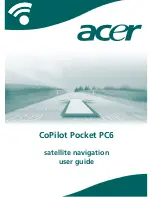
88
Appendix D. An Introduction to Disk Partitions
Warning
Many people have successfully used
fips
to resize their hard drive partitions. However, because
of the nature of the operations carried out by
fips
and the wide variety of hardware and software
configurations under which it must run, Red Hat cannot guarantee that
fips
will work properly on
your system. Therefore, no installation support is available for
fips
.
Use it at your own risk.
That said, if you decide to repartition your hard drive with
fips
, it is
vital
that you do two things:
•
Perform a backup
— Make two copies of all the important data on your computer. These copies
should be to removable media (such as tape or diskettes), and you should make sure they are read-
able before proceeding.
•
Read the documentation
— Completely read the
fips
documentation, located in the
dosutils/fipsdocs
subdirectory on Red Hat Linux/x86 CD 1.
Should you decide to use
fips
, be aware that after
fips
runs you will be left with
two
partitions: the
one you resized, and the one
fips
created out of the newly freed space. If your goal is to use that
space to install Red Hat Enterprise Linux ES, you should delete the newly created partition, either
by using
fdisk
under your current operating system or while setting up partitions during a custom
installation.
D.1.5. Partition Naming Scheme
Linux refers to disk partitions using a combination of letters and numbers which may be confusing,
particularly if you are used to the "C drive" way of referring to hard disks and their partitions. In the
DOS/Windows world, partitions are named using the following method:
•
Each partition’s type is checked to determine if it can be read by DOS/Windows.
•
If the partition’s type is compatible, it is assigned a "drive letter." The drive letters start with a "C"
and move on to the following letters, depending on the number of partitions to be labeled.
•
The drive letter can then be used to refer to that partition as well as the filesystem contained on that
partition.
Red Hat Enterprise Linux ES uses a naming scheme that is more flexible and conveys more infor-
mation than the approach used by other operating systems. The naming scheme is file-based, with
filenames in the form:
/dev/
xxyN
Here is how to decipher the partition naming scheme:
/dev/
This string is the name of the directory in which all device files reside. Since partitions reside
on hard disks, and hard disks are devices, the files representing all possible partitions reside in
/dev/
.
xx
The first two letters of the partition name indicate the type of device on which the partition
resides. You will normally see either
hd
(for IDE disks) or
sd
(for SCSI disks).
Summary of Contents for LINUX ES 2.1 -
Page 1: ...Red Hat Enterprise Linux ES 2 1 Red Hat Enterprise Linux ES Installation Guide...
Page 10: ......
Page 18: ...8 Chapter 1 Steps to Get You Started...
Page 72: ......
Page 74: ...64 Appendix A Removing Red Hat Enterprise Linux ES...
Page 86: ...76 Appendix C Troubleshooting Your Installation of Red Hat Enterprise Linux ES...
Page 102: ...92 Appendix D An Introduction to Disk Partitions...
Page 110: ......













































